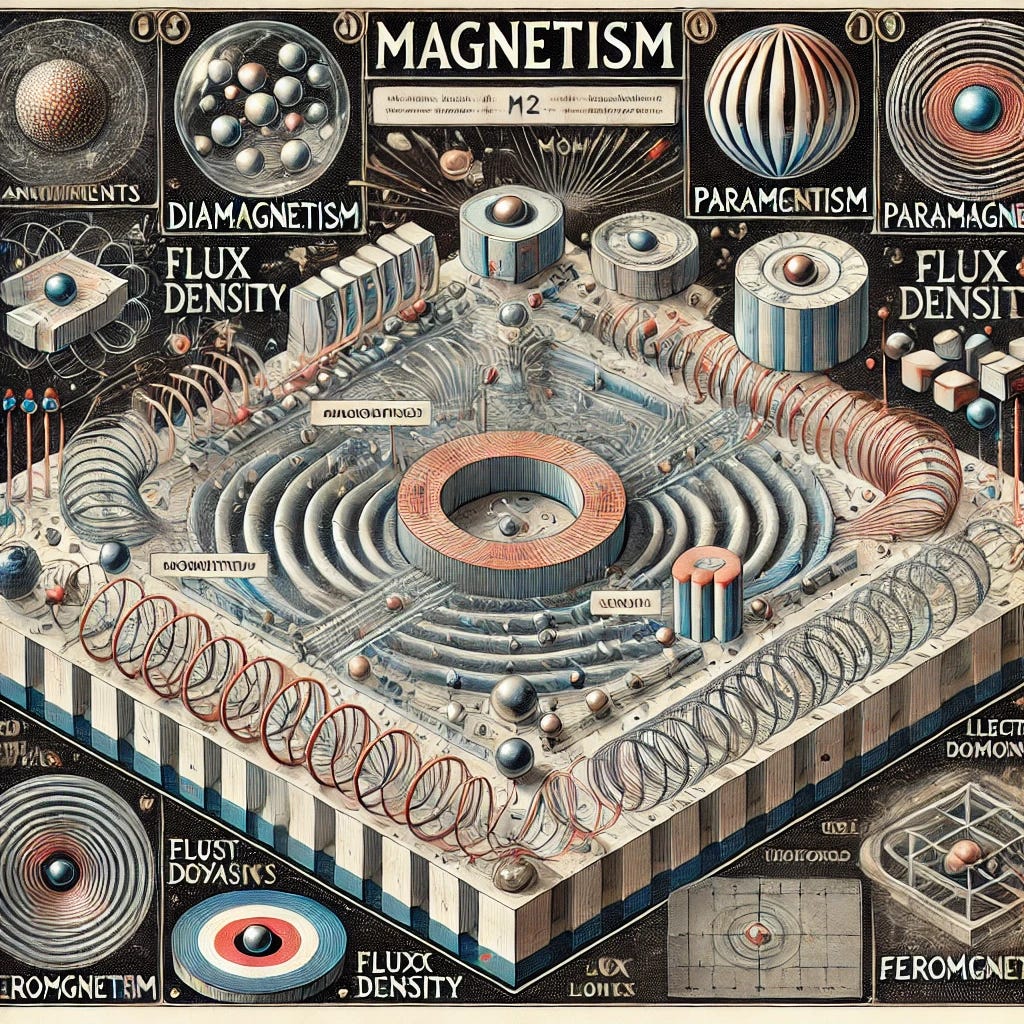Comprehensive Overview of Magnetism: From Magnetic Moments to Flux Density
A Deep Dive into Magnetic Properties, Material Classification, and Engineering Applications

Decoding the Fundamentals of Magnetic Interactions
Introduction
Magnetism is a fundamental property exhibited by all materials to varying extents, dictating their responses to external magnetic fields. This comprehensive overview categorizes materials based on their magnetic behaviors, ranging from negligible to highly responsive. Key concepts such as magnetic moments, flux density, and field interactions are essential for applications across fields like magnetic storage, electromagnetic machinery, and medical imaging. By exploring these principles, we gain insights into the atomic and molecular interactions that drive magnetic responses and open new pathways in engineering and technology.
Classifying Magnetic Materials
1. Nonmagnetic Materials
These materials, such as wood and rubber, are largely unaffected by magnetic fields and show negligible magnetic response. Their magnetic properties are akin to those of air or a vacuum.
2. Diamagnetic Materials
Diamagnetic substances, including copper and silver, produce a weak magnetic field in opposition to an applied external field. As a result, they exhibit slight repulsion from magnetic poles.
3. Paramagnetic Materials
Materials like aluminum and platinum slightly enhance the passage of magnetic field lines. They align their magnetic fields with the external field, offering subtle reinforcement to the applied field.
4. Ferromagnetic Materials
Highly magnetic materials like iron, nickel, and cobalt exhibit robust magnetic properties. Their atomic magnetic moments align with external fields, creating stable, powerful magnetic domains that remain even after the external field is removed, particularly in hard ferromagnetic materials.
The Concept of Magnetic Moments and Electron Motion
Electrons moving in orbits around an atomic nucleus produce magnetic fields, forming what is known as the electron's magnetic moment. This moment is the foundational unit of magnetic interaction at the atomic level:
Aligned Magnetic Moments: When electrons orbit in parallel directions, they reinforce each other’s magnetic fields, amplifying the overall field.
Opposing Magnetic Moments: Electrons orbiting in opposite directions cancel each other's magnetic effects, resulting in a null magnetic field. Nonmagnetic materials exhibit this effect, whereas magnetic materials align to generate a net magnetic field.
Magnetic Domains and Material Magnetization
In ferromagnetic materials, groups of atoms form magnetic domains, regions with aligned magnetic moments. The alignment of these domains under an external magnetic field amplifies the material’s magnetic response.
Soft Magnetic Materials: Easily demagnetized, such as soft iron, which quickly loses magnetization after the external field is removed.
Hard Magnetic Materials: Retain their magnetic domains' alignment, making them suitable for permanent magnets.
Magnetic Flux and Flux Density
Magnetic flux (Φ) represents the total magnetic field in a given area, while flux density (B) is the flux per unit area. Flux density, measured in teslas (T), illustrates the concentration of magnetic lines, which diminishes with distance from the magnetic source.
Example Calculation of Flux Density
Consider a bar magnet with a flux of 2×10−4 Wb2 \times 10^{-4} \, \text{Wb}2×10−4Wb:
Within the Magnet: Given a cross-sectional area of 1 cm21 \, \text{cm}^21cm2:
B=2×10−4 Wb1×10−4 m2=2 TB = \frac{2 \times 10^{-4} \, \text{Wb}}{1 \times 10^{-4} \, \text{m}^2} = 2 \, \text{T}B=1×10−4m22×10−4Wb=2T
At a Distance: Spread over an area of 2 cm×2 cm2 \, \text{cm} \times 2 \, \text{cm}2cm×2cm:
B=2×10−4 Wb(2×10−2)2 m2=0.5 TB = \frac{2 \times 10^{-4} \, \text{Wb}}{(2 \times 10^{-2})^2 \, \text{m}^2} = 0.5 \, \text{T}B=(2×10−2)2m22×10−4Wb=0.5T
Engineering Applications of Magnetic Materials
Magnetic materials are essential in modern technology:
Static Magnetic Forces: Used in holding devices, magnetic bearings, and clutches.
Electromagnetic Forces: Power motors, loudspeakers, and other devices by creating controlled magnetic motion.
Electromagnetic Induction: Foundational in generators and sensors for inducing voltage via changing magnetic fields.
Medical Imaging: Magnetic resonance imaging (MRI) leverages strong magnetic fields to visualize internal body structures.
Key Takeaways
This exploration into magnetism provides a framework for understanding how various materials interact with magnetic fields. From the subtleties of diamagnetic repulsion to the powerful alignment of ferromagnetic domains, each material’s unique properties are crucial in the design of magnetic devices. The theory of magnetism underpins innovations in technology, transforming applications in fields as diverse as manufacturing, medicine, and energy production.
References
Ahmad, Amna. "The Theory of Magnetism Explained." Amna Ahmad Journal, February 13, 2023.
Cullity, B. D., & Graham, C. D. Introduction to Magnetic Materials. Wiley-IEEE Press, 2008.
Coey, J. M. D. Magnetism and Magnetic Materials. Cambridge University Press, 2010.
O’Handley, R. C. Modern Magnetic Materials: Principles and Applications. Wiley, 2000.
Understanding these principles not only enriches scientific knowledge but also fuels technological advancements, shaping how magnetic materials are used and developed in diverse fields.

